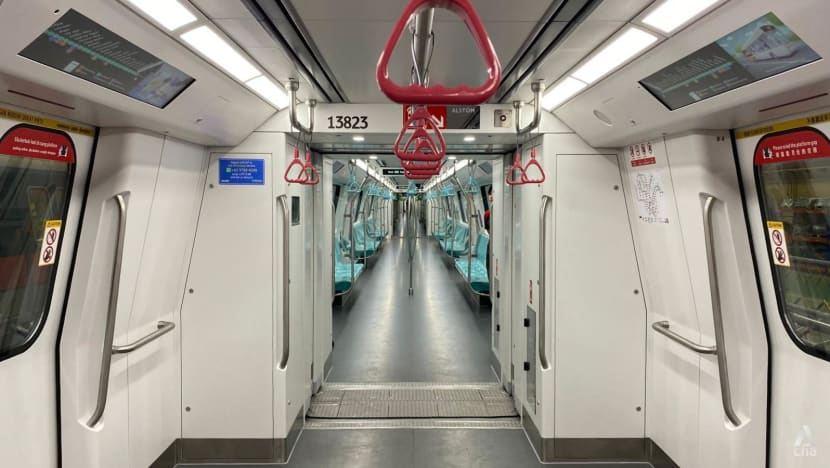New train fleets, track circuit, power supply systems: North-South, East-West MRT lines complete renewal works
Started in 2012, renewal and upgrading works were rolled out in phases to the North-South and East-West MRT lines’ six core systems: Sleepers, third rail, signalling system, track circuits, power supply and train fleet.

There will be more cabin space for wheelchair users and strollers in the new North-South and East-West Line MRT trains. (Photo: CNA/Grace Yeoh)
This audio is AI-generated.
SINGAPORE: The multi-year programme to renew and upgrade the six core systems of the North-South and East-West MRT lines (NSEWL) was completed on Wednesday (Oct 25).
The six core systems are the sleepers, third rail, signalling system, track circuits, power supply and train fleet.
Since 2012, the rail network improvement programme has conducted comprehensive renewal and upgrading works to the systems in phases.
With three of its core systems – sleepers, third rail and signalling system – completed before 2020, renewal works since then have been focused on finishing the rest.
A common feature of the renewed track circuit and power supply systems, as well as the new train fleets, is a “condition monitoring feature to allow faults to be pre-emptively addressed”, said the Land Transport Authority (LTA).
This allows prevention of service disruptions and before it causes a wider system failure or disruption.
RENEWAL OF TRACK CIRCUIT SYSTEM
LTA on Wednesday said the new track circuit system will enhance rail reliability. It can also help to detect “broken rails in need of repair”, reducing the risk of disruption and enabling more efficient preventive maintenance.
The new track circuits work in tandem with the Communications-Based Train Control signalling system, which was completed in 2018, to indicate the position of all trains on track. This helps the operator focus its response efforts and speed up train recovery in the event of a fault, minimising the impact on commuters.
Replacement works for the NSEWL’s track circuit system began in 2018, and more than 1,100 track circuits have been replaced. Some minor track circuit works still ongoing are slated for completion in December.

POWER SUPPLY RENEWAL
Meanwhile, the NSEWL’s new power supply system has enhanced features for real-time monitoring, which improves fault detection and prediction, LTA said.
It will, for example, constantly monitor the insulation of traction cables, enabling the operator to assess their condition and take “appropriate pre-emptive interventions” where necessary.
The power supply renewal works, which began in 2018, “encompassed the replacement of 1,300km of power cables, 250km of fibre-optic cables, and hundreds of power transformers and switchboards”, said Acting Minister Chee Hong Tat at the completion ceremony on Wednesday.
“The total length of all the power cables is equivalent to almost six times the length of Singapore’s coastline.”
All NSEWL stations have also replaced the 64P touch voltage protection systems with new Voltage Limiting Devices to “isolate power faults and prevent line-wide disruptions”, added LTA.
NEW TRAIN FLEETS
LTA in 2018 ordered the production and delivery of 66 trains to progressively replace the first-generation NSEWL trains.
Another 40 new trains were purchased in 2020 to replace second- and third-generation trains. These new trains were equipped with sensors to monitor the performance of various train subsystems and track conditions, enabling early fault detection.
In total, 26 new trains have arrived in Singapore. Seven are in passenger service, while the remaining 19 are undergoing testing and commissioning.
The rest of the trains will arrive in Singapore and be put progressively into service from now until 2026.

The replacement of wooden sleepers with concrete sleepers was completed in December 2016, while replacement of the third rail was completed in September 2017.
The third rail supplies power to trains, while sleepers are used to help hold tracks in place.
“Back in 2012, the North-South-East-West Line was operating with a mean kilometres between failure (MKBF) figure of about 65,000 train-kilometres. By 2019, we achieved our target of 1 million MKBF, and we have maintained this high level of reliability ever since,” added Mr Chee.
“Looking ahead, as our rail network continues to grow, different parts will also continue to age and have to be renewed. The scale and complexity of renewal works will only increase.
“Our commitment to the renewal and maintenance efforts (for) our rail network will become even more important to deliver a safe, efficient and reliable commuting experience for Singaporeans.”







